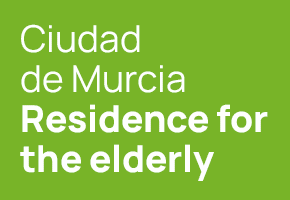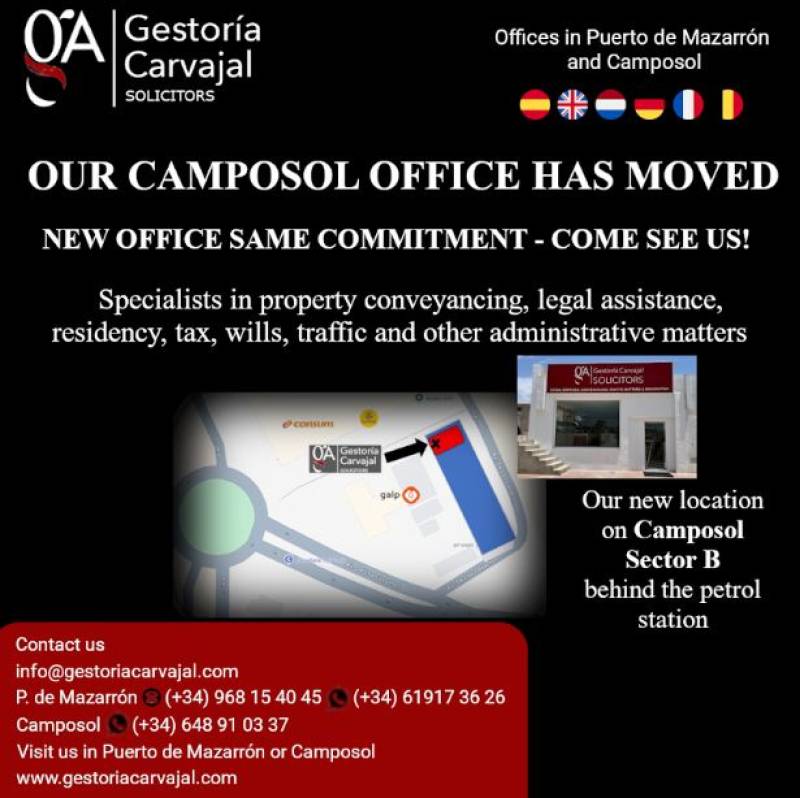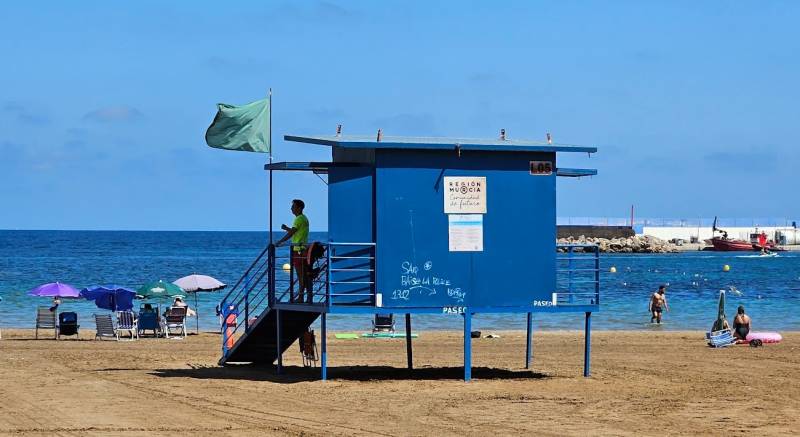- Region
- Águilas
- Alhama de Murcia
- Jumilla
- Lorca
- Los Alcázares
- Mazarrón
- San Javier
-
ALL AREAS & TOWNS
- AREAS
- SOUTH WEST
- MAR MENOR
- MURCIA CITY & CENTRAL
- NORTH & NORTH WEST
- TOWNS
- Abanilla
- Abarán
- Aguilas
- Alamillo
- Alcantarilla
- Aledo
- Alhama de Murcia
- Archena
- Balsicas
- Blanca
- Bolnuevo
- Bullas
- Cañadas del Romero
- Cabo de Palos
- Calasparra
- Camping Bolnuevo
- Campo De Ricote
- Camposol
- Canada De La Lena
- Caravaca de la Cruz
- Cartagena
- Cehegin
- Ceuti
- Cieza
- Condado de Alhama
- Corvera
- Costa Cálida
- Cuevas De Almanzora
- Cuevas de Reyllo
- El Carmoli
- El Mojon
- El Molino (Puerto Lumbreras)
- El Pareton / Cantareros
- El Raso
- El Valle Golf Resort
- Fortuna
- Fuente Alamo
- Hacienda del Alamo Golf Resort
- Hacienda Riquelme Golf Resort
- Isla Plana
- Islas Menores & Mar de Cristal
- Jumilla
- La Azohia
- La Charca
- La Manga Club
- La Manga del Mar Menor
- La Pinilla
- La Puebla
- La Torre
- La Torre Golf Resort
- La Unión
- Las Palas
- Las Ramblas
- Las Ramblas Golf
- Las Torres de Cotillas
- Leiva
- Librilla
- Lo Pagan
- Lo Santiago
- Lorca
- Lorquí
- Los Alcázares
- Los Balcones
- Los Belones
- Los Canovas
- Los Nietos
- Los Perez (Tallante)
- Los Urrutias
- Los Ventorrillos
- Mar De Cristal
- Mar Menor
- Mar Menor Golf Resort
- Mazarrón
- Mazarrón Country Club
- Molina de Segura
- Moratalla
- Mula
- Murcia City
- Murcia Property
- Pareton
- Peraleja Golf Resort
- Perin
- Pilar de la Horadada
- Pinar de Campoverde
- Pinoso
- Playa Honda
- Playa Honda / Playa Paraíso
- Pliego
- Portmán
- Pozo Estrecho
- Puerto de Mazarrón
- Puerto Lumbreras
- Puntas De Calnegre
- Region of Murcia
- Ricote
- Roda Golf Resort
- Roldan
- Roldan and Lo Ferro
- San Javier
- San Pedro del Pinatar
- Santiago de la Ribera
- Sierra Espuña
- Sucina
- Tallante
- Terrazas de la Torre Golf Resort
- Torre Pacheco
- Totana
- What's On Weekly Bulletin
- Yecla


- EDITIONS:
 Spanish News Today
Spanish News Today
 Alicante Today
Alicante Today
 Andalucia Today
Andalucia Today
Date Published: 11/11/2024
The Mazarron Phoenician boat is successfully raised from seabed
The keel of the shipwreck is the last of the 22 sections to be recovered after two months of painstaking work
 The Phoenician vessel 'Mazarrón II' which has lain on the seabed for over 2,600 years, dating back to the second half of the seventh century BC has been raised successfully.
The Phoenician vessel 'Mazarrón II' which has lain on the seabed for over 2,600 years, dating back to the second half of the seventh century BC has been raised successfully.
The keel of the boat was the final part to be extracted on November 6 in a precise underwater operation that started in early September, it was the last of the 22 sections into which the boat was divided to protect the integrity of the structure during its extraction.
The extraction and correlation operation carried out in-situ just off La Isla beach, Puerto de Mazarrón has been planned for sometime after it was found that the underwater protective metal box placed over the wreck to conserve it was starting to sink into the sand and would eventually, if left, have crushed the boat.
This however has been prevented, after the vessel was mapped and divided, stern to bow, into 22 sections following existing cracks and fissures in the framework to enable the parts to be lifted to the surface. Because of its age and construction, it would have been impossible to raise the boat in one piece.
 With the extraction work completed, the operation moves to the National Museum of Underwater Archaeology in Cartagena (Arqva) where the next phase of study, restoration and conservation of the wood begins. Here the sections can be kept in a sealed environment and the process of fitting the sections of the boat back together for a future exhibition to the public. Scientists and researchers participating in this phase will allow them to learn more about the life habits and customs of the time.
With the extraction work completed, the operation moves to the National Museum of Underwater Archaeology in Cartagena (Arqva) where the next phase of study, restoration and conservation of the wood begins. Here the sections can be kept in a sealed environment and the process of fitting the sections of the boat back together for a future exhibition to the public. Scientists and researchers participating in this phase will allow them to learn more about the life habits and customs of the time.
UNESCO recognition
The extraction project of the 'Mazarrón II' wreck has been included in UNESCO’s Register of Good Practices of Underwater Cultural Heritage. Accrediting the precision of the planning and work in an operation undertaken by the Murcia regional government, in collaboration with the National Museum of Underwater Archaeology of Cartagena since 2018. Over this period the team has carried out a series of archaeological actions to monitor and control the vessel’s state of conservation on the seabed.
In 2021, in order to guarantee its protection and safeguard the precious find for the enjoyment of future generations, it was decided to investigate the possibility of removing the wreck from its precarious situation.
After a process of debate, it was concluded that the most appropriate solution was to extract the Phoenician ship, given the instability of its situation on the seabed and the risk of further deterioration or total loss. This decision was endorsed at the international meeting of experts held at Arqva in May 2021, under the auspices of UNESCO and with the participation of the international scientific community working on underwater archaeological heritage.
 Specialists in underwater archaeology and ancient naval architecture participated in these works, as well as professionals in the restoration of archaeological pieces from the sea.
Specialists in underwater archaeology and ancient naval architecture participated in these works, as well as professionals in the restoration of archaeological pieces from the sea.
Future legacy
The Phoenician ship is part of a set of two ships found off the La Isla beach and both the wrecks and the underwater site are considered an Asset of Cultural Interest (BIC), thus protecting the entire area. This site is characterised, so far, by the presence of two ships dating back to the sixth century B.C. The first wreck 'Mazarrón I', consisting of a four-metre section of the keel, a plank and cylindrical pieces of wood that seem to correspond to the frames of the ship are preserved in the National Museum of Underwater Archaeology (Arqva).
The second boat 'Mazarrón II', was preserved practically complete, at the site of the discovery, protected by a metal frame and covered by sand in order to guarantee its conservation. The boat has a length of 8.15 metres and a beam of 2.25 metres, it was built with cypress, Aleppo pine and olive wood, and was located in 1995 with all its cargo, the crew's possessions and the anchor, the oldest of its kind.
The wreck should be ready for public display within five years. It remains to be determined whether its final destination will be Cartagena or a dedicated museum and convention centre in Mazarrón.
For more local news, events and other information go to the home page of Mazarrón Today
Images: ARQVA
Contact Murcia Today: Editorial 000 000 000 /
Office 000 000 000































